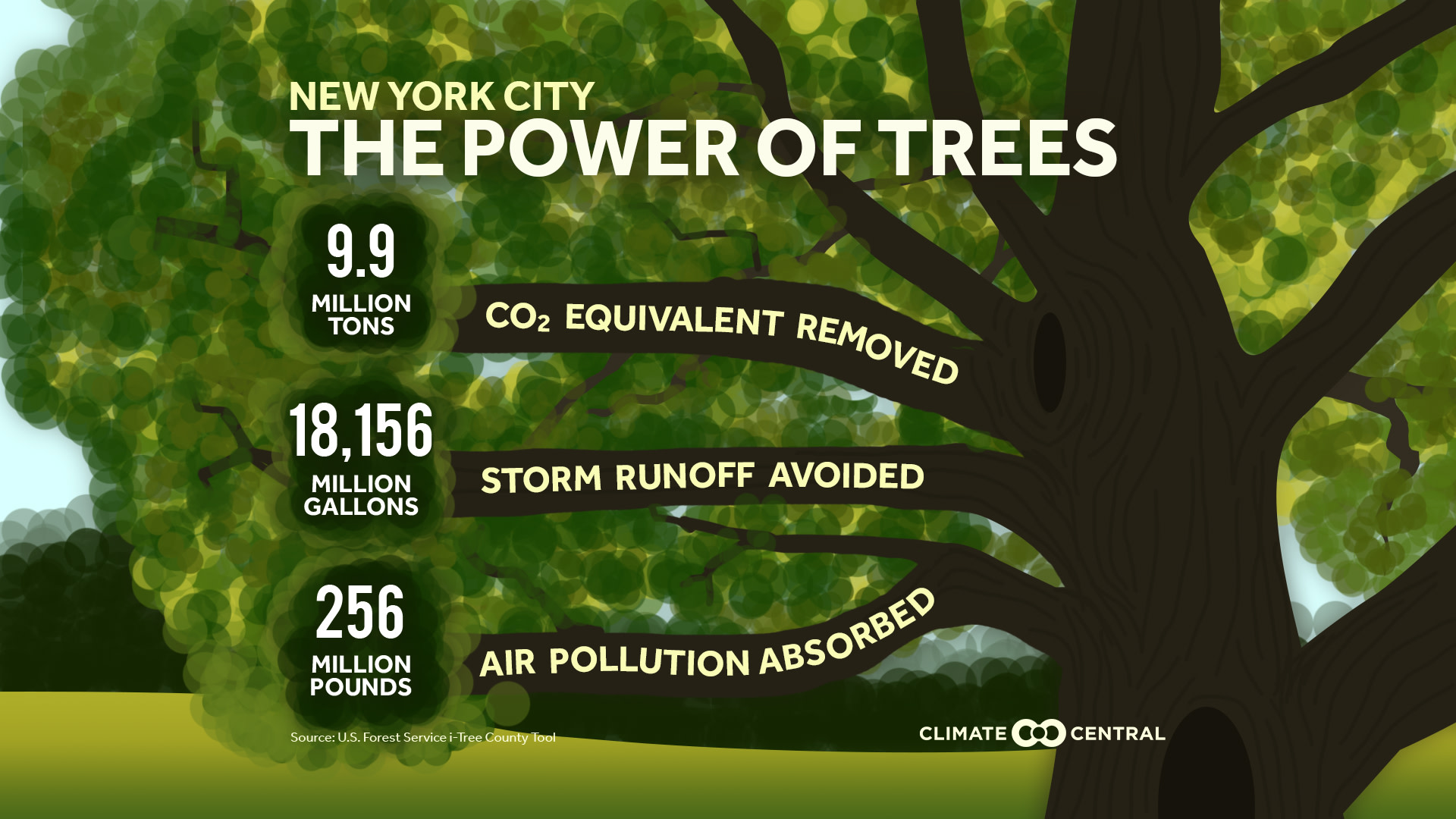KEY CONCEPTS
Cities can get much hotter than surrounding suburban and rural areas, particularly at night. This is because of the "urban heat island" effect, in which concrete, pavement, bricks and other hard surfaces absorb heat in urban areas during the daytime, then release it during the evenings.
Within cities, tree cover and temperature can vary largely between streets and neighborhoods. Papers published this year have helped illuminate and quantify the injustices of urban heat in 'redlined' neighborhoods, typically home to Black and immigrant communities, that have less canopy cover and higher temperatures than their whiter areas.
WHAT YOU NEED TO KNOW
Extreme heat and heat streaks are worsening worldwide because of the heat-trapping effects of fossil fuel and other types of pollution. The effects are being felt the most in cities, where natural landscapes have been replaced with concrete, brick buildings and blacktop. Extreme heat and heat-related illness can be deadly, particularly to those who are older or less healthy, who have limited access to health care, and who cannot afford air conditioning.
Trees help reduce heat by providing shade and by drawing water up through their roots and releasing it into the air through their leaves. They also clean the air and reduce stormwater runoff. Shrubs, grasses, vegetated 'green' roofs, community gardens and the like provide similar benefits.
Large parks in cities can provide cooling-off destinations and have been particularly valuable during the COVID pandemic, providing park goers with an opportunity to cool down outdoors while observing social distancing guidelines. Street trees are more expensive to maintain and more difficult to keep alive than those growing in parks, but they help keep surrounding neighborhoods cool.
Vacant lots and other underused space within cities have the potential to be turned into "pocket parks" or public spaces, allowing for small stands of trees to be dotted around neighborhoods without clearing or purchasing land for large new parks. Redevelopment projects can also provide opportunities to retrofit cities with additional tree coverage through creative urban design.
Access to parks and open space have implications for public health beyond heat. They provide opportunities for exercise and relaxation, which can boost physical and mental health.
RESOURCES FOR COVERING HEAT
Hotter Climate, More Cooling Demand (Aug. 12, 2020) including local analyses of cooling degree day trends since 1970.
Heat Streaks are Stretching (Aug. 19, 2020) including local analyses of peak heat streak duration across the U.S. since 1970
2020 Summer Package (May 27,2020) including local analyses of overnight low temperature trends since 1970
RECENT RESEARCH
Residential housing segregation and urban tree canopy in 37 US Cities. Joint federal, academic and nonprofit-based research published in August showing the extent to which formerly redlined neighborhoods around the U.S. today contain substantially less foliage.
The Effects of Historical Housing Policies on Resident Exposure to Intra-Urban Heat: A Study of 108 US Urban Areas. Researchers in Virginia and Oregon published this paper in January, showing that most redlined areas have higher land surface temperatures than other neighborhoods by as much as 7°C, or 12°F.
NATIONAL MEDIA COVERAGE
Can Planting Trees Make a City More Equitable? By Patrick Sisson, Bloomberg CityLab, Aug. 28, 2020.
Poor Neighborhoods Feel Brunt Of Rising Heat. Cities Are Mapping Them To Bring Relief. By Mose Buchele, KUT90.5/NPR, Aug. 28, 2020.
How Decades of Racist Housing Policy Left Neighborhoods Sweltering. By Brad Plumer and Nadja Popovich, New York Times, Aug. 24, 2020.
Summers are getting hotter, but not all Wilmington neighborhoods feel it equally. By Jeanne Kuang and Krys'tal Griffin, Delaware News Journal, July 30.
A lot of the scientific research underway nationally on this topic began in Baltimore, where the Howard Center for Investigative Journalism, NPR and Capital News Service collaborated to produce an award-winning series last year titled, Code Red: Baltimore’s Climate Divide.
POTENTIAL LOCAL STORY ANGLES
Visit parks and neighborhoods on hot days and ask people you encounter about the heat. You may find that some people are traveling a long way to cool down in parks. Residents can often describe the temperature differences in different areas and share views on the unequal impacts.
Speak with your city and obtain budget data to investigate whether it's investing more money maintaining trees and parks in wealthier areas than in poorer ones. Neighborhood groups and leaders could provide information and context for stories about urban heat and vegetation.
For a map of temperatures in your city, this database from the Trust For Public Land may be useful. And for maps of tree cover, try the University of Vermont's growing inventory of high-resolution tree canopy maps or i-Tree. You could also search the internet and ask local city officials, scientists and community groups whether they're aware of additional local heat and canopy mapping projects. And NOAA coordinated heat mapping in 13 U.S. cities this summer.
The City Heat Project by Molly Peterson in California was among the growing number of reporting projects that have used temperature sensors, which can be purchased for under $100 apiece. Scientists and other researchers sometimes have sensors available to borrow.
INTERVIEW SUGGESTIONS
Chandana Mitra
Auburn University
Associate Professor, Department of Geosciences
czm0033@auburn.edu
Alessandro Rigolon
University of Utah
Assistant Professor, Department of City & Metropolitan Planning
alessandro.rigolon@utah.edu
Morgan Grove
U.S. Department of Agriculture
Research Forester, Communities and Landscapes of the Urban Northeast
morgan.grove@usda.gov
Jennifer Wolch
UC Berkeley
Professor of City and Regional Planning
wolch@berkeley.edu
